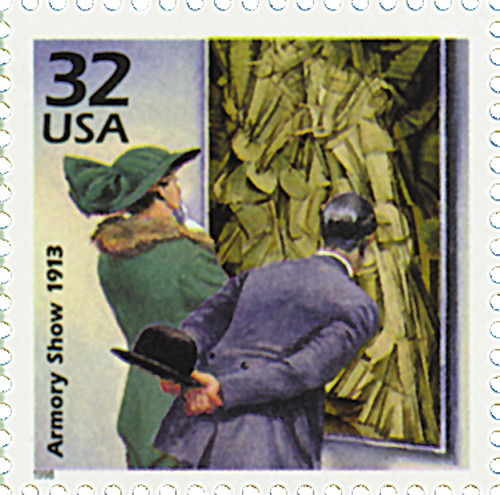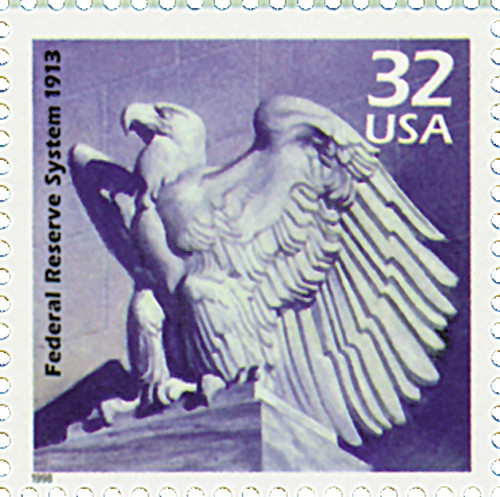
# 3183i - 1998 32c Celebrate the Century - 1910s: U.S. Enters World War I
US #3183i
1998 US Enters World War I – Celebrate the Century (1910s)
• Part of the second sheet in the Celebrate the Century stamp series issued from 1998-2000
• Commemorates US entry into World War I
• Includes text on the back with historical details
Stamp Category: Commemorative
Series: Celebrate the Century
Value: 32¢ First Class Mail Rate
First Day of Issue: February 3, 1998
First Day City: Washington, DC
Quantity Issued: 188,000,000
Printed by: Ashton Potter (USA) Ltd.
Printing Method: Offset, Intaglio
Format: Panes of 15
Perforations: 11.6
Tagging: Block Tagging
Why the stamp was issued: To document the United States’ entry into World War I and the over 116,500 brave Americans who lost their lives in service to their country.
About the stamp design: Pictures the famous Uncle Sam recruiting poster from World War I. Includes the following text on the back “Two million American soldiers fought in Europe during World War I and more than 116,500 lost their lives. Back home, more than one million women joined the workforce.”
First Day City: The First Day of Issue Ceremony was held in Washington, DC, with legendary radio and television host Larry King as master of ceremonies.
About the Celebrate the Century series: The USPS launched the Celebrate the Century series in 1998 to mark the end of the 20th century and herald the arrival of the 21st. The series includes 10 sheets of 15 stamps (150 in total), with each honoring important moments from a different decade (1900s, 10s, 20s, 30s, 40s, 50s, 60s, 70s, 80s, and 90s). At the time of completion, it was the longest and most ambitious commemorative stamp series in US history.
History the stamp represents: On September 7, 1813, the Troy Post published an article on the War of 1812 that included an early printed use of Uncle Sam to represent the United States. The article stated, “Loss upon loss, and no ill luck stir[r]ing but what lights upon Uncle Sam’s* shoulders, exclaim the Government editors in every part of the country… *This cant name for our government has got almost as current as ‘John Bull.’ The letters U.S. on the government wagons, &c., are supposed to have given rise to it.”
Two weeks later, another newspaper in Burlington, Vermont sent out a call for volunteers to protect private property from attacking British troops. The article said that there was a shortage of enlisted men because “Uncle Sam, the now popular explication of the U.S. does not pay well.”
Over the years, Uncle Sam was pictured in a variety of ways – including closely resembling Benjamin Franklin during the Civil War. Thomas Nast’s political cartoons of the 1870s introduced the famous outfit – striped pants, a tailcoat, and a tall hat. Nast also took qualities from Abraham Lincoln and used them to draw Uncle Sam in his cartoons.
Uncle Sam was first illustrated as we know him today during World War I. His most famous appearance was on a recruitment poster created by James Montgomery Flagg. Flagg’s image of Uncle Sam as an elderly man with white hair, goatee, and red, white, and blue top hat struck a chord with Americans. Flagg didn’t want to bother hiring a model, so instead based Uncle Sam on himself, aging his own features. The poster depicted a stern image of Uncle Sam declaring, “ WANT YOU FOR U.S. ARMY.” The poster was printed over four million times and was so successful that it is still a national icon over 100 years later.
US #3183i
1998 US Enters World War I – Celebrate the Century (1910s)
• Part of the second sheet in the Celebrate the Century stamp series issued from 1998-2000
• Commemorates US entry into World War I
• Includes text on the back with historical details
Stamp Category: Commemorative
Series: Celebrate the Century
Value: 32¢ First Class Mail Rate
First Day of Issue: February 3, 1998
First Day City: Washington, DC
Quantity Issued: 188,000,000
Printed by: Ashton Potter (USA) Ltd.
Printing Method: Offset, Intaglio
Format: Panes of 15
Perforations: 11.6
Tagging: Block Tagging
Why the stamp was issued: To document the United States’ entry into World War I and the over 116,500 brave Americans who lost their lives in service to their country.
About the stamp design: Pictures the famous Uncle Sam recruiting poster from World War I. Includes the following text on the back “Two million American soldiers fought in Europe during World War I and more than 116,500 lost their lives. Back home, more than one million women joined the workforce.”
First Day City: The First Day of Issue Ceremony was held in Washington, DC, with legendary radio and television host Larry King as master of ceremonies.
About the Celebrate the Century series: The USPS launched the Celebrate the Century series in 1998 to mark the end of the 20th century and herald the arrival of the 21st. The series includes 10 sheets of 15 stamps (150 in total), with each honoring important moments from a different decade (1900s, 10s, 20s, 30s, 40s, 50s, 60s, 70s, 80s, and 90s). At the time of completion, it was the longest and most ambitious commemorative stamp series in US history.
History the stamp represents: On September 7, 1813, the Troy Post published an article on the War of 1812 that included an early printed use of Uncle Sam to represent the United States. The article stated, “Loss upon loss, and no ill luck stir[r]ing but what lights upon Uncle Sam’s* shoulders, exclaim the Government editors in every part of the country… *This cant name for our government has got almost as current as ‘John Bull.’ The letters U.S. on the government wagons, &c., are supposed to have given rise to it.”
Two weeks later, another newspaper in Burlington, Vermont sent out a call for volunteers to protect private property from attacking British troops. The article said that there was a shortage of enlisted men because “Uncle Sam, the now popular explication of the U.S. does not pay well.”
Over the years, Uncle Sam was pictured in a variety of ways – including closely resembling Benjamin Franklin during the Civil War. Thomas Nast’s political cartoons of the 1870s introduced the famous outfit – striped pants, a tailcoat, and a tall hat. Nast also took qualities from Abraham Lincoln and used them to draw Uncle Sam in his cartoons.
Uncle Sam was first illustrated as we know him today during World War I. His most famous appearance was on a recruitment poster created by James Montgomery Flagg. Flagg’s image of Uncle Sam as an elderly man with white hair, goatee, and red, white, and blue top hat struck a chord with Americans. Flagg didn’t want to bother hiring a model, so instead based Uncle Sam on himself, aging his own features. The poster depicted a stern image of Uncle Sam declaring, “ WANT YOU FOR U.S. ARMY.” The poster was printed over four million times and was so successful that it is still a national icon over 100 years later.












